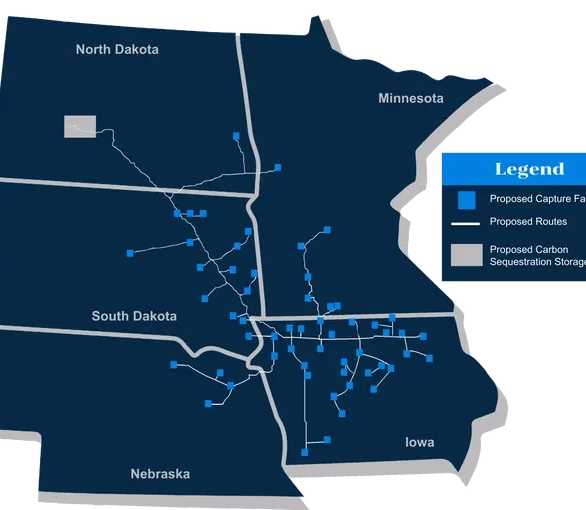
What could Summit’s proposed carbon pipeline look like in Iowa? See the map.
Iowa could be one of five states to have a pipeline traverse through its land after the Iowa Utilities Board approved a construction request from Summit Carbon Solutions to build one in the state.
The approval from the Iowa Utilities Board took two and a half years of debate. Just because Summit has the state of Iowa’s blessing, doesn’t mean construction of the 2,500-mile pipeline can begin. Summit must abide by rules set out by the IUB’s ruling, get permission from other affected states and work with landowners.
So what should you know about the carbon pipeline debate taking place in Iowa and the Midwest?
What is a carbon pipeline?
Carbon pipelines are part of the carbon capture and storage system intended to reduce man-made carbon emissions, according to the Congressional Research Services. Carbon sequestration, also known as carbon storage, is the process of storing carbon emitted from industries underground. The pipeline system captures and transports the carbon to storage facilities. In Summit Carbon Solutions’ case, the pipeline will be capturing carbon emitted by ethanol plants all across the Midwest.
Pipelines are not the only mechanism to transport captured carbon. Other means include railways and shipping, according to the Department of Energy.
What kind of pipeline is Summit proposing to build in Iowa?
Summits proposed pipeline is designed to span 2,500 miles across five states.
The pipeline would be buried a minimum of 48 inches deep, according to Summit Carbon Solutions. The pipeline’s walls could be anywhere from 0.189 inches to 0.75 inches thick. It would be made out of high-strength steel. The diameter of the pipeline system will likely range from 4 to 24 inches, according to Summit.
The pipeline would transport 12 million metric tons of carbon dioxide every year.
When will Summit’s carbon pipeline be built?
Construction is expected to begin in 2025, and operations could start as early as 2026.
But Summit must cross multiple hurdles, including complying with Iowa regulations and gaining regulatory approval from other states before construction can begin. Original plans were denied by regulators in North Dakota and South Dakota.
Summit Carbon Solution’s map shows route pipelines would take across Iowa

What did the Iowa Utilities Board decide regarding Summit’s carbon pipeline?
The Iowa Utilities Board granted Summit permission to use eminent domain to acquire land from owners unwilling to sell it. Landowners and tenants will have to be compensated for any damages that result from constructing the pipeline.
The Iowa Utilities Board is requiring Summit to obtain more than $100 million liability insurance policy before construction permits are approved. Summit will also have to follow standards implemented by the board when constructing the pipeline. The requirements include:
- Conduct X-ray inspections of all welds, test pipeline coatings and test the line at high pressure.
- Use thicker-walled pipe and fracture arrestors “where appropriate.”
- Provide carbon dioxide monitors for every emergency truck, fire truck, law enforcement vehicle and ambulance in communities the pipeline crosses.
- Provide grants to cities and counties to purchase the equipment they would need to deal with a pipeline-related incident.
- Equip each county on the pipeline route with an alarm system that would notify authorities of leaks.
What is eminent domain?
Eminent domain is the government’s power to take private land for public benefit, according to the Iowa Utilities Board.
Eminent domain is granted for public ownership, such as highways or parks or for private ownership that serves a public use, such as railroads, energy facilities or communication facilities that are regulated as common carriers. Eminent domain cannot be granted to take property from one person purely to favor another person.
The Iowa Utilities Board is granted the power of eminent domain regarding electric power generating plants, electric transmission lines, intrastate natural gas pipelines and hazardous liquid pipelines. Summit said it has reached agreements with more than 2,700 landowners.
Why has the pipeline been controversial over the last few years?
The pipeline has faced opposition from environmental groups, landowners and both political parties in Iowa. A group of 31 Republicans from the Iowa House and Senate released a statement condemning the IUB’s decision.
Summit and its supporters believe the pipeline will benefit the ethanol and agriculture industry. Summit has said the construction will bring 11,00 temporary jobs and 1,100 permanent jobs once the project is operational.
What’s next for the proposed pipeline?
Summit plans to file a permit request from North Dakota for the route and sequestration site. It also needs approval on the route from South Dakota. Minnesota and Nebraska still have to approve the company’s construction of trunk or lateral lines to the ethanol plants in those states.
